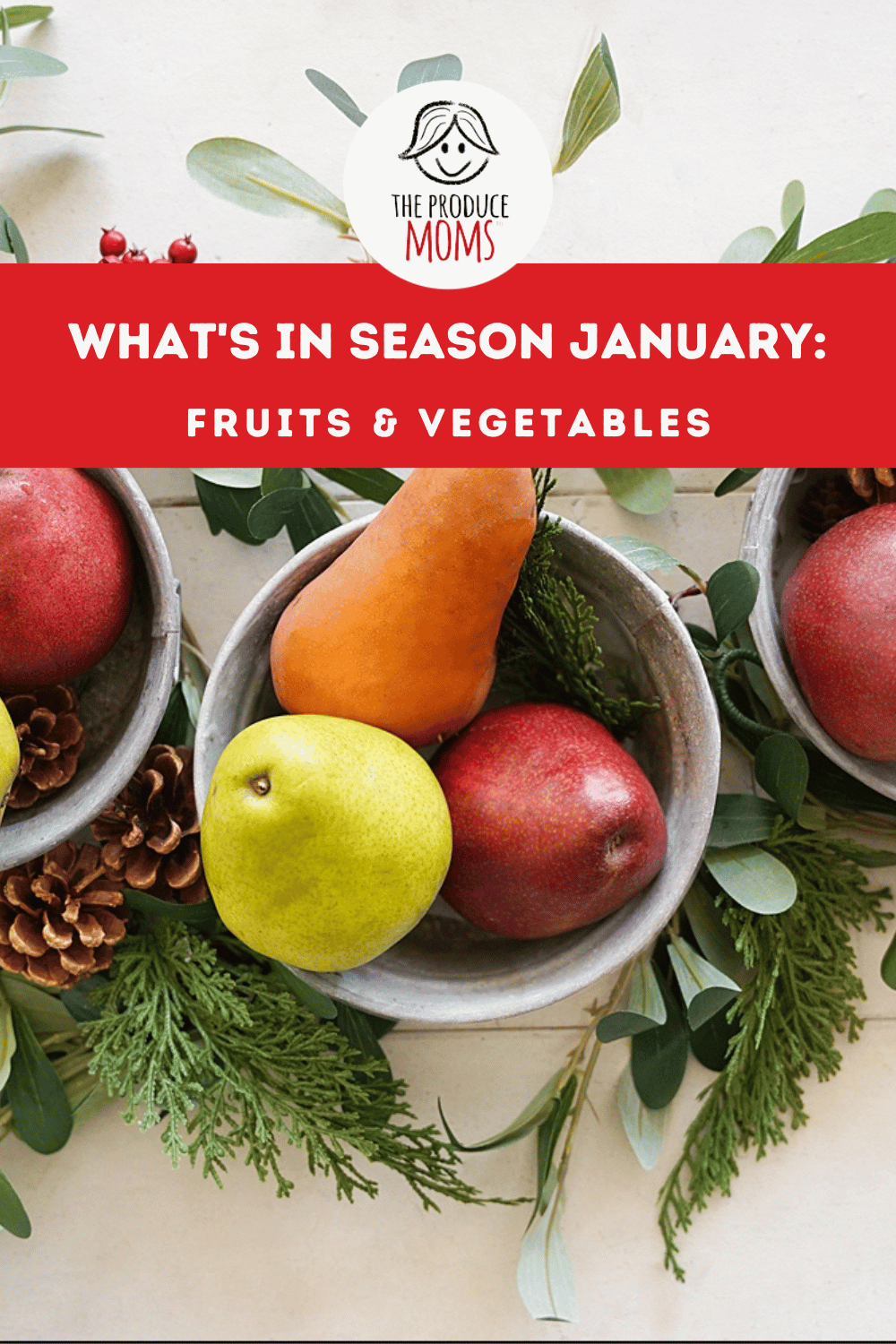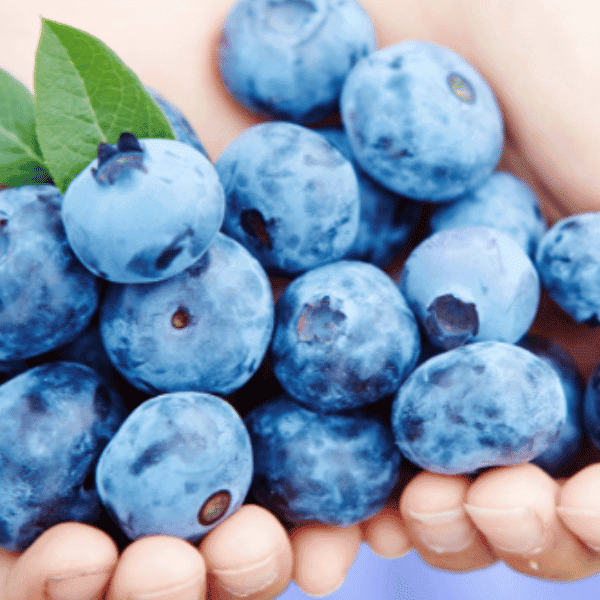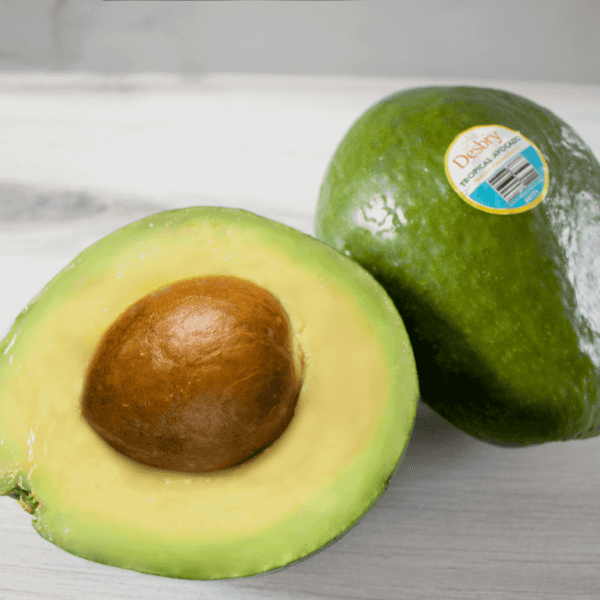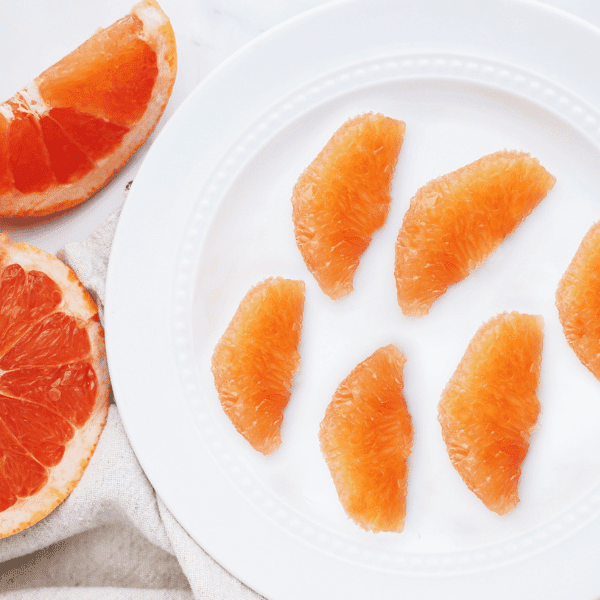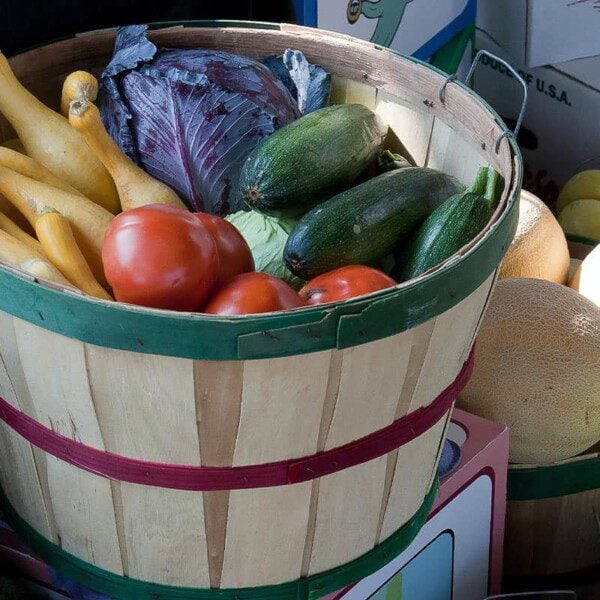What’s in Season January: Fruits & Vegetables
Jan 01, 2023, Updated Jan 30, 2023
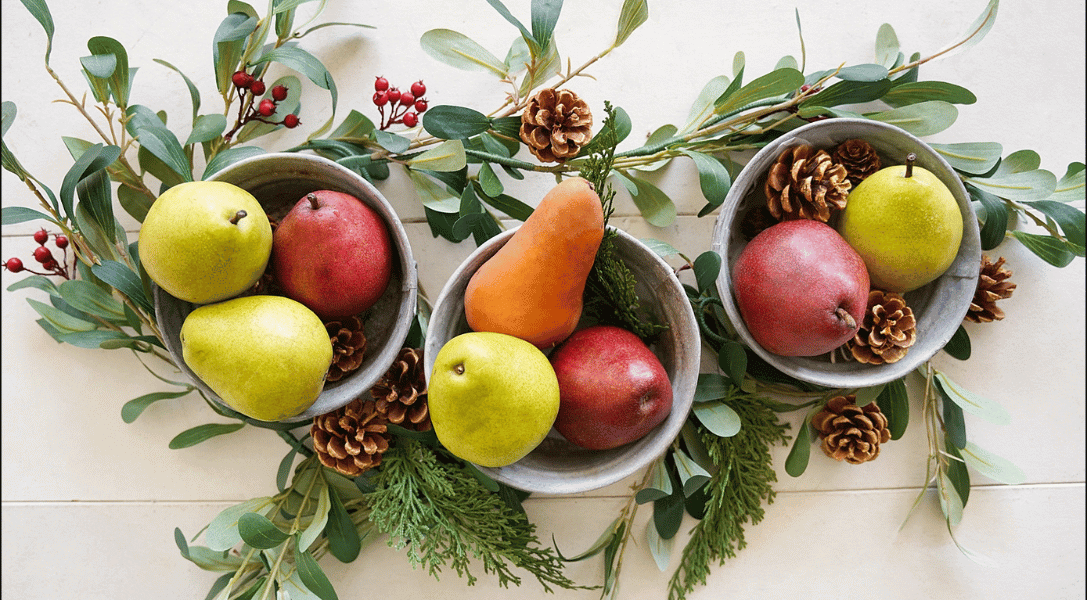
This post may contain affiliate links. Please read our disclosure policy.
January is the month of new beginnings. Is your new beginning this year going to be about buying fruits and vegetables that are in season? It’s the best way to experience these healthy foods at their peak flavors, and you’ll save a little money in the process!
We want to help you enjoy all the in season fruits and vegetables this January, which is why we’ve created this detailed guide! Check out our list of what’s in season in January.
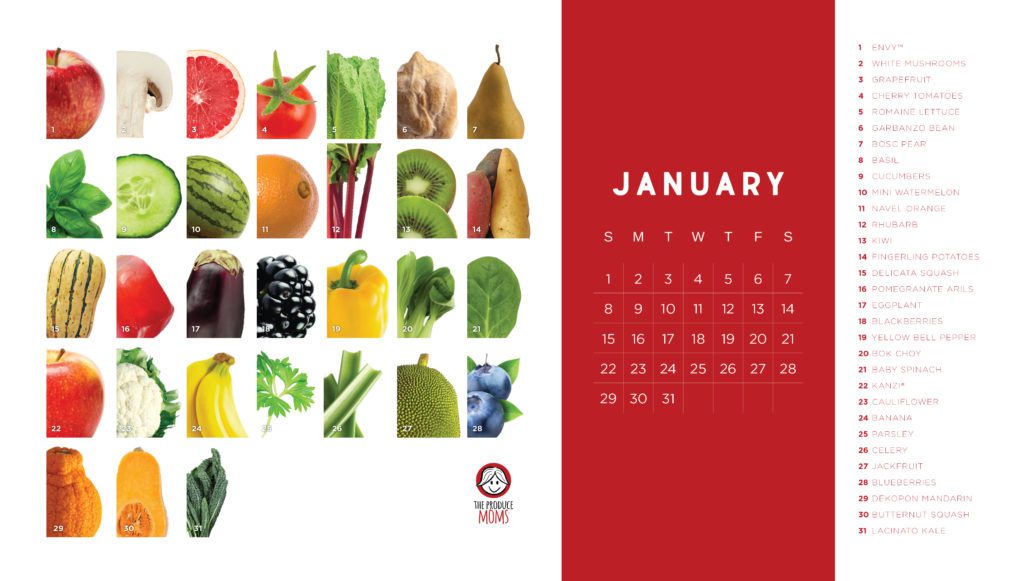
Fruits in Season January
Let’s kick things off by exploring the fruits that are in season in January.
Envy™
Envy apples are a hybrid of Royal Gala and Braeburn apples. It has a distinctively sweet, sophisticated flavor with an indulgent aroma. The skin of these apples is mostly red with yellow specks and is very firm. The natural sweetness of Envy apples makes them a perfect choice for our Apple Blondie Cupcakes recipe!
EverCrisp®
EverCrisp is another type of apple that’s sweet, juicy, and firm. These apples are a cross between Fuji and Honeycrisp apples. You’ll get a nice crunch followed by a ton of juicy sweetness every time you bite into an EverCrisp apple. You’ll know these apples are perfectly ripe when they lose any green color and the flesh inside is tender, white, and juicy.
Blackberries
Blackberries have a succulent, tart flavor. They’re juicy, perfect for smoothies, and absolutely delicious. It’s easy to tell when blackberries are ripe because they’ll have that classic deep purple color, feel tender, and be perfectly plump. You can use these berries in pies, smoothies, yogurt, and much more!
Related: Blackberries: How to Select, Store & Serve
Blueberries
Blueberries aren’t just a delicious treat. These berries contain helpful vitamins and minerals that can help prevent cardiovascular disease and type 2 diabetes. Ripe blueberries will have that distinctive blue color while looking and feeling plump. These berries are perfect for adding to pancakes, smoothies, yogurt, or eating as a snack. Check out our Lemon Blueberry Scones recipe for a tasty treat!
Bosc Pear
When you see a painting or drawing of a bowl of fruit and notice a pear, it’s almost always a bosc pear. You’ll know these pears are perfectly ripe when they give a little when you apply pressure to the stem area. These pears have a unique deep cinnamon color and have a sweet and slightly spicy flavor.
Cherry Tomatoes
Bright and sweet, cherry tomatoes make the perfect addition to any salad. They’re small, about the size of cherries, and these little fruits pack a solid amount of flavor. This type of tomato has a thin, snappy peel that delivers a satisfying crunch every time! You’ll know cherry tomatoes are ripe when they’re perfectly red, yellow, orange, or purple (depending on the variety).
Fuji Apple
Fuji apples are another sweet winter treat that’s in season in January. Fuji apples often taste similar to apple juice you’d buy at the store because they have a sugary-sweet flavor. Their flavor makes them perfect for delicious apple-themed desserts like apple pie, apple crumble, or apple turnovers.
Related: Know Your Apple Varieties
Grapefruit
Grapefruit is one of those fruits that people either love or hate; there’s no in-between! People who dislike this fruit for its tart, bitter flavor have probably never tried our Grapefruit Avocado Spinach Salad recipe! You can make this fruit taste delicious when combining it with other flavors, and adding a tablespoon of sugar while eating it raw will make it a whole new experience.
Kiwi
Kiwi has a very unique flavor that some describe as a cross between pineapple, banana, and strawberry. It’s super easy to tell when these fruits are ripe. All you need to do is hold it in the palm of your hand and press it gently. If you feel the kiwi give, then it’s ripe and ready to eat! Enjoy this fruit raw, throw it in a smoothie, or try your hand at making kiwi bread. Kiwis also come with great health benefits – learn more.
Mango
Mangoes give you the gift of summer flavors in the middle of the winter. These fruits are citrusy, sweet, and carry a hint of melon. Ripe mangos are soft and should form a little dent when you apply pressure with your finger. These fruits are excellent for smoothies, salsa, and citrus salads.
Related: How To Slice A Mango
Navel Orange
When you want a combination of sweet and mild acidity, navel oranges are a perfect choice. These citrus fruits are full of vitamins A and C, and they contain 6% of your daily intake of calcium! Navel oranges are best cut up and eaten raw, but they’re also perfect for smoothies and our Navel Orange And Beet Salad recipe.
Related: 5 Ways to Cut a Navel Orange
Pinkglow Pineapple
If you’ve never heard of Pinkglow Pineapples, then perhaps you’ve heard it called by its other names- Rose Pineapple or Jewel of the Jungle. These fruits look similar to traditional pineapples, except their flesh is a gorgeous rose-pink color! They taste a bit less sour than traditional pineapples and have some candy sweetness notes. This fruit is perfect when cut up and eaten raw and makes a great, colorful addition to any fruit salad.
Pomegranate Arils
Pomegranate arils are simply the seeds of the fruit. Pomegranate arils can be sprinkled into salads and oatmeal, or you can sprinkle them on top of avocado toast for a citrusy twist. They’re also incredibly healthy for you, and research suggests pomegranate seed oil can help people with type 2 diabetes control their blood sugar levels!
Red Grapes
Red grapes are known for their sweet, crisp flavor and hard skin. Some of the best wines are made from red grapes, but these fruits also have plenty of other uses. They’re a great snack by themselves and are also perfect in our Rainbow Fruit Tray With Pot Of Gold Fruit Dip recipe.
Strawberry
Strawberries are an excellent healthy snack rich in vitamin C, folate, potassium, and iron. They’re juicy and sweet, with just the right amount of acidity. You can tell strawberries are ripe when they’re plump and perfectly red. Enjoy your strawberries in smoothies, desserts, or with our Grilled Chicken And Strawberry Salad recipe.
Vegetables in Season January
Now that we’ve covered all the delicious sweet treats in season in January, it’s time to talk about the variety of vegetables you can enjoy this month!
Basil
While many people know basil as an herb that adds a unique sweet/peppery flavor to your dishes. Basil is technically an herb, but herbs are a subset of vegetables, so it definitely counts on our list.
This versatile herb can be used in nearly any dish, and it has a super unique flavor profile that will enhance your cooking to the next level.
Black Beans
Beans and legumes are a subgroup of vegetables, and black beans are perfectly in season during the month of January. They have a soft and mild flavor that blends well with a wide variety of dishes. There’s some research suggesting that black beans can lower insulin sensitivity in people with diabetes or obesity, so this is an excellent healthy food to add to your diet.
Related: Black Bean Burgers
Celery
Crispy, bitter, and earthy, celery has a pretty unique flavor. This vegetable is perfect for adding a crunch to your salads or topping with peanut butter for a quick protein snack. Celery is full of vitamins A, C, and K, so it’s a super healthy food with a great flavor. Try out our list of 10 ways to use celery here.
Cucumber
Cucumbers have a very mild flavor due to their high water content, and they’re a bit sweeter than most vegetables. You’ll know a cucumber is ripe when it’s a bright medium to dark green color and firm. Due to their mild flavor, you can use this veggie in most recipes, and it’s a great way to add some nutrients to your kid’s diet.
Related: Growing Cucumbers? 7 Tips For A Massive Harvest
Delicata Squash
Delicata squash is a variety of winter squash and is easily recognizable by its yellow skin with green stripes. These vegetables have an interesting flavor, usually described as a cross between a sweet potato and butternut squash. You’ll know your delicata squash is ripe when it’s nice and firm and heavier than you’d expect it to be. Check out our Delicata Squash Dried Cranberry Salad!
Red Onion
Red onions have a distinctive purple exterior with a reddish inner flesh. They taste very similar to yellow onions when cooked but are a bit milder when eaten raw. These veggies are packed full of vitamin B6, vitamin C, biotin, and copper. If you’re looking for a different way to enjoy this vegetable, try our Red Onion Marmalade recipe!
Red Potatoes
Red potatoes have a deep red skin color and a flavor that’s a bit more subtle and sweet than russet potatoes. They have a waxier texture that makes them perfect for roasting, soups, and salads. Red potatoes are a delicious food that makes the perfect side to any dish.
Russet Potatoes
Russet potatoes are a bit heftier than red potatoes. They have a more noticeable earthy flavor than red potatoes, and their skin is thicker as well. These potatoes are perfect for making mashed potatoes, french fries, and hash. They also come out great in our Roasted Potato Soup recipe.
Romaine
Romaine is a type of lettuce that’s bright green, refreshing, and juicy. It offers a great crunchiness to salads and has a mildly bitter flavor. Romaine is full of healthy vitamins and minerals that can help lower your risk of chronic diseases such as cardiovascular disease and cancer.
Related: Grilling Romaine Lettuce: Grilled Ceaser Salad
Rhubarb
Rhubarb typically has a reddish color and provides an extremely tart flavor. This veggie is crunchy, like celery when raw, but nice and soft when cooked. Most people mix some sugar into their rhubarb dishes to offset their super tart flavor. This is a great veggie to add to your diet because it’s excellent at improving digestion!
Snow Peas
Snow peas are earthy, mild, and crisp when raw. Cooking snow peas tenderizes them, and this versatile vegetable adds a delightful burst of flavor to many dishes. They’re ideal for salads or as a side. They’re also the star of our Snow Pea Stir-Fry recipe. You can eat the entire pod as well as the peas inside.
Swiss Chard
Swiss chard is another leafy green vegetable with a mild, sweet flavor similar to spinach. It’s often added to salads and provides an excellent crunch with every bite. This vegetable is high in vitamin C, flavonoids, sodium, and fiber. Try adding some to your next salad for an extra dose of essential minerals.
Tropical Avocado
Avocados are technically a fruit, but most people classify them as a vegetable due to their mild, nutty flavor. Tropical avocados taste slightly sweeter than traditional Haas avocados, but they’re still perfect for making dip and guacamole. Use these fruits for toast, cakes, or pies to enjoy their unique sweet flavor.
Related: Tropical Avocados 101
Turnip
Turnips are a delicious root vegetable with a purple, red, or greenish top color. The bottoms are a creamy white, and they’re often described as having a sweet, nutty, and earthy flavor. There are dozens of ways you can enjoy this vegetable, but we particularly love our Oven Roasted Turnip recipe!
White Mushroom
While white mushrooms are considered fungi, they’re also classified as a vegetable. White mushrooms are in season during different months depending on your location and can be in season year-round in certain places! These mushrooms have a noticeable earthy flavor with a firm yet rubber texture.
Produce in Season for January
So, were you surprised by anything on this list? Hopefully, we gave you some great new ideas for recipes you and your whole family can enjoy. Spend this January eating fruits and veggies that are in season. Your palate and your wallet will thank you!
